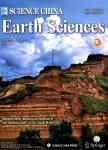Carbon sinks/sources in the Yellow and East China Seas Air-sea interface exchange, dissolution in seawater, and burial in sediments
Carbon sinks/sources in the Yellow and East China Seas—Air-sea interface exchange, dissolution in seawater, and burial in sediments作者机构:Key Laboratory of Marine Ecology and Environmental Sciences Institute of Oceanology Chinese Academy of Sciences Qingdao 266071 China Function Laboratory of Marine Ecology and Environmental Sciences Qingdao National Laboratory for Marine Science and Technology Qingdao 266237 China University of Chinese Academy of Sciences Beijing 100049 China Center for Ocean Mega-Science Chinese Academy of Sciences Qingdao 266071 China
出 版 物:《Science China Earth Sciences》 (中国科学(地球科学英文版))
年 卷 期:2018年第61卷第11期
页 面:1583-1593页
核心收录:
学科分类:083001[工学-环境科学] 0830[工学-环境科学与工程(可授工学、理学、农学学位)] 07[理学] 0707[理学-海洋科学] 08[工学] 0708[理学-地球物理学] 0704[理学-天文学]
基 金:supported by the Strategic Priority Research Program of the Chinese Academy of Sciences (Grant No. XDA11020102) the Joint Fund between the National Natural Science Foundation of China and Shandong Province (Grant No. U1606404) the Program for Aoshan Excellent Scholars of Qingdao National Laboratory for Marine Science and Technology (Grant No. 013ASTP-OS13)
摘 要:The sinks/sources of carbon in the Yellow Sea(YS) and East China Sea(ECS), which are important continental shelf seas in China, could exert a great influence on coastal ecosystem dynamics and the regional climate change process. The CO_2 exchange process across the seawater-air interface, dissolved and particulate carbon in seawater, and carbon burial in sediments were studied to understand the sinks/sources of carbon in the continental shelf seas of China. The YS and the ECS generally have different patterns of seasonal air-sea CO_2 exchange. In the YS, regions west of 124°E can absorb CO_2 from the atmosphere during spring and winter, and release CO_2 to the atmosphere during summer and autumn. The entire YS is considered as a CO_2 source throughout the year with respect to the atmosphere, but there are still uncertainties regarding the exact air-sea CO_2 exchange flux. Surface temperature and phytoplankton production were the key controlling factors of the air-sea CO_2 exchange flux in the offshore region and nearshore region of the YS, respectively. The ECS can absorb CO_2 during spring, summer, and winter and release CO_2 to the atmosphere during autumn. The annual average exchange rate in the ECS was-4.2±3.2 mmol m^(-2) d^(-1) and it served as an obvious sink for atmospheric CO_2 with an air-sea exchange flux of 13.7×10~6 t. The controlling factors of the air-sea CO_2 exchange in the ECS varied significantly seasonally. Storage of dissolved inorganic carbon(DIC) and dissolved organic carbon(DOC) in the YS and the ECS were 425×10~6 t and 1364×10~6 t, and 28.2×10~6 t and 54.1×10~6 t,respectively. Long-term observation showed that the DOC content in the YS had a decreasing trend, indicating that the practical carbon sink in the YS was decreasing. The total amount of particulate organic carbon(POC) stored in the YS and ECS was10.6×10~6 t, which was comparable to the air-sea CO_2 flux in these two continental shelf seas. The amounts of carbon sequestered by phyto



